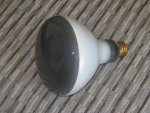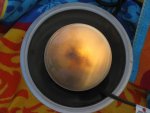John, it's interesting that you point out that issue with the loose neutral. Yesterday when I disconnected the pool light hot and neutral connections at the j-box, I noticed that the neutral connection was probably weak because the installer had stripped a lot of the strands of wire off when stripping the insulation. However, I have not experienced any on/off/intermittent behavior. Once the first bulb started going dim, it just continued to get dimmer until it was gone. The new one is doing the same thing. But for sure I'll be redoing that connection so there's more stranded wire making connection. I haven't made any current measurements yet. We have had the pool and spa lights on at the same time quite often. The spa light has always seemed OK.
Craig, I think 2-3 ohms seems low also, and I'm thinking that the bulb may have read differently when it was new. I'm going to grab a new 100W bulb from the house today and put it in there. I'm going to measure its resistance before putting it in there, and check it again after it's been on for several hours (my failing bulb only has 5-6 total hours on it). As long as I have the fixture 'open' (no glass lens and gasket installed) I should be OK with it being out of water with the light on, right? The thermal thing is interesting, because the new bulb is a higher wattage (500 vs. 400 on the original) and it started dimming very soon compared to the first one. But my initial theory is that something happened somewhere in the circuit fairly recently, and the dimming on the first bulb also happened quickly once there was a problem with the circuit. But right now, who knows? Perhaps the 100W bulb thing that I'm about to do will tell us something.
Just in case it gives any clue as to what's happening, I want to mention that the failing bulb is very dark all around the front of the glass. I've attached a picture so you can see what I mean. I've seen failed light bulbs look dark, but not like this.
Also, the light fixture is a Pentair Amerlite. I can't seem to find a model number in the owner's manual. And the fixture itself has a part number for the enclosure, but not a model number. I have the Amerlite model that goes together with a tension ring, rather than several screws all around it. I thought that the fixture housing was the exact same for the 300, 400, and 500W models, but I better double-check on that. I may have been wrong upgrading this thing with a 500W bulb. The wire size is 16 gauge I believe, which should have no problem carrying the additional amount of current, but perhaps too much heat is building up in the fixture housing. On the other hand, my older 400W bulb died the same kind of death also (dimming until gone).
I'll also mention that the newer bulb is not OEM, but rather it's a cheap Feit replacement that's actually rated at 130W, not 120.
Oh well, I'm going to connect things at the j-box again and check a few more things out.
Thanks,
Greg



